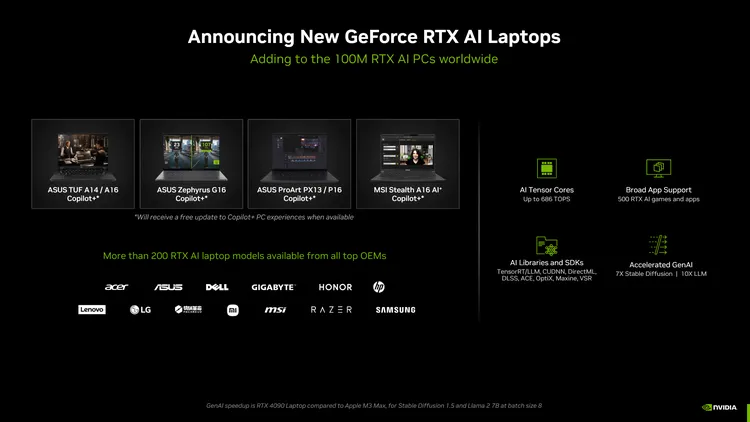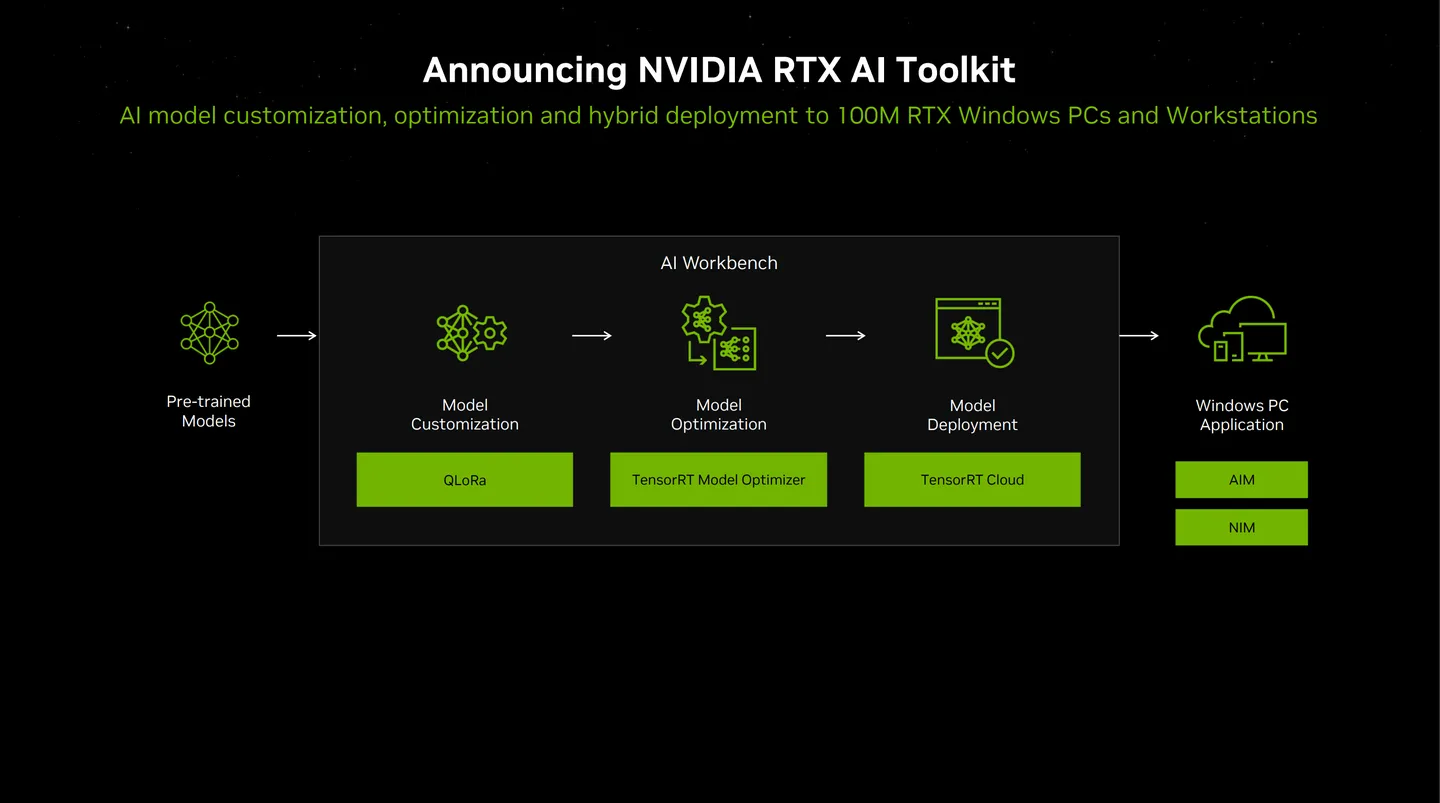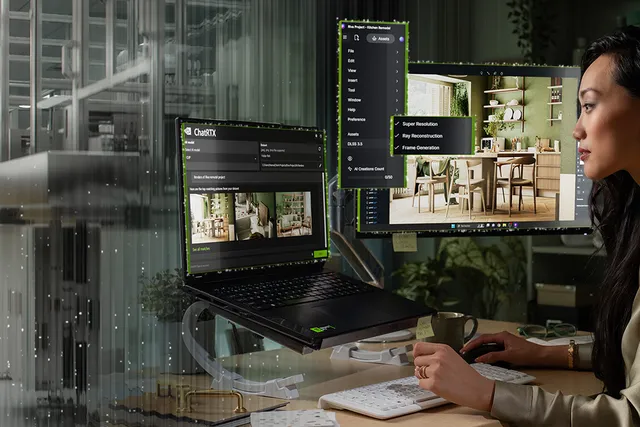Nvidia and AMD are preparing to release new gaming laptops that will feature advanced AI tools. These laptops will come with Nvidia’s powerful GeForce RTX 4070 graphics cards and AMD’s latest Strix processors. They will also run on Windows 11, which includes Microsoft’s new AI Copilot Plus features designed to enhance performance and user experience.
At the Computex event, Nvidia previewed these upcoming laptops from brands like Asus and MSI, highlighting their high-performance specs. These laptops are expected to leverage both Nvidia’s graphics technology and AMD’s new processors to deliver top-tier gaming experiences and efficient computing.
However, there’s a catch: the first batch of these AMD-powered laptops might not include all the new AI features from Microsoft right at launch. This means that while the laptops will be advanced and powerful, some of the promised AI enhancements may be added in future updates.

Nvidia has announced that Windows 11 AI PCs will eventually receive a free update to include Copilot+ PC features when they become available. This means that while these new laptops will be advanced, they might not initially support all of Microsoft’s latest AI tools. There could be a delay or a period where these AI features are exclusive to laptops running on Qualcomm’s Windows on Arm chips, which are set to launch soon. Nvidia is still clarifying exactly what this update will entail.
Meanwhile, Nvidia is working hard to stay competitive in the AI space. As Microsoft moves forward with using specialized chips called NPUs (Neural Processing Units) for AI tasks, Nvidia is focusing on showcasing how its graphics cards (GPUs) can handle AI tasks effectively. Nvidia is emphasizing that its GPUs are well-suited for running complex AI processes, which it believes gives them an edge over NPUs in certain applications.
In summary, while Windows 11 AI PCs will get new AI features in the future, there may be initial delays or exclusivity for other hardware. Nvidia is positioning its GPUs as strong contenders for AI tasks, aiming to highlight their capabilities in a market where specialized AI chips are becoming more common.

In June, Nvidia is set to release an RTX AI Toolkit, which will provide developers with a suite of tools and software development kits (SDKs) for customizing, optimizing, and deploying AI models. This toolkit aims to enhance AI models like Meta’s Llama 2 by making them more efficient, reducing their VRAM requirements, and improving overall performance. This move is part of Nvidia’s broader strategy to offer solutions that make AI more accessible and effective for various applications.
Nvidia is also collaborating with Microsoft to advance the AI features embedded in Windows 11. This partnership will enable developers to use Nvidia’s GPUs to accelerate small language models, which are crucial for tasks like retrieval-augmented generation (RAG). These models will be supported by Microsoft’s Windows Copilot Runtime, a platform designed to simplify the integration of AI features into applications, whether developers use NPUs (Neural Processing Units) or Nvidia’s powerful GPUs.
Microsoft’s Windows Copilot Runtime, announced last month, is designed to help developers easily incorporate AI functionalities into their apps. This runtime will facilitate access to GPU-accelerated models, making it easier for applications to leverage advanced AI capabilities. Nvidia’s collaboration aims to ensure that these AI enhancements can be effectively utilized with their RTX GPUs, providing a powerful alternative to the NPUs used in some other devices.
The performance differences between NPUs and Nvidia’s GPUs are quite pronounced. NPUs are optimized for high efficiency and smaller AI models, making them suitable for power-sensitive devices like laptops. In contrast, Nvidia’s GPUs can handle significantly more complex models, offering over 1,000 TOPS (Tera Operations Per Second) for AI tasks, which is much higher than the ~40 TOPS of NPUs. This allows GPUs to deliver superior performance for demanding AI applications, particularly in desktop environments where power consumption is less of a concern.
As the AI landscape on PCs continues to evolve, it will be intriguing to observe how these technologies compete and complement each other. Microsoft plays a pivotal role in integrating these advancements into Windows, working with various hardware providers like Nvidia, AMD, Intel, and Qualcomm. The outcome of this competition will shape how AI features develop and are adopted across different computing platforms, influencing the future of both consumer and professional applications.
In summary, Nvidia’s upcoming RTX AI Toolkit and its collaboration with Microsoft on AI-enhanced Windows 11 features represent significant advancements in the PC industry. By providing powerful tools for optimizing AI models and facilitating easy integration into applications, Nvidia and Microsoft are shaping the future of AI on PCs. The performance gap between Nvidia’s high-capacity GPUs and more efficiency-focused NPUs highlights the diverse needs of different computing environments, from desktops to laptops.
To stay updated on the latest news and developments in laptops and PCs, including innovations from leading companies like Nvidia and Microsoft, visit (starhifi.com)Star Office International. For more information and updates, check out Star Office International located in Putalisadak, Kathmandu.


